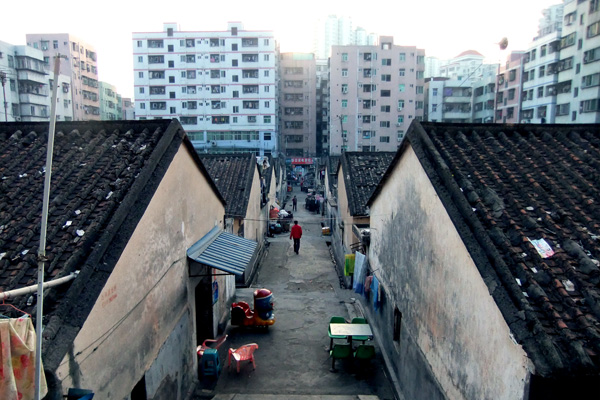
Shennan Road is the oldest east-west artery in Shenzhen, until a few years ago when the opening of the northern loop and the Binhai road, it was both Main Street (in the sense of the center of town activities) and the main artery for transporting goods and people from one side of the city to the other. Today, most trucks travel from factories along the northern loop, crossing the border at either Wenjindu or Huanggang, and most cars and all express buses travel along Binhai. However, Shennan Road has maintained its symbolic and functional importance in the organization of the city.
This weekend, I went for a walk along the strip of Shennan Road between the old city hall and the recently opened new city hall. There’s much to be said about the difference between the two buildings, but the point I want to emphasize here is the inscription of history through architecture that is visible along this strip. It is, in many respects a history that can be understood through the movement from the low, concrete municipal building (a Stalinist concrete block), representing the idea of Shenzhen as a manufacturing center to the post-modern glass and steel of the new municipal building, which points to Shenzhen’s aspirations in global finance and management. All this to say, throughout the strip one encounters concrete factory buildings and modernist office buildings that abut newer, taller, and more expensive buildings.
This twenty-five year history is also the history of replacing the collectivist economy with a market economy. This history, while less visible than the progression from manufacturing to finance manifest in the city halls, is nevertheless a structuring feature of this bit of land. This structuring has several levels.
• First, twenty-five years ago, when Shenzhen planners first approached the project of opening the west, they only marked the land from Luohu train station to the Shanghai Hotel. That is to say, for many years when Shenzhen residents said they were going into town, they meant the area between the train station and the Shanghai hotel. This means that the new city center has been moved from the original downtown to what was previously a leechee orchard outside the scope of the original urban plan. Traces of this other history remain in Shenzhen’s center park, which stretches alongside the new city center, large tracks of which are still used to cultivate leechees.
• Second, the transfer of commune land to urban work units predicated this transformation. The Ministry of Aviation developed the area on which the Shanghai hotel was built. The Ministry of Aviation annexed this land from the Shangbu Commune, which is memorialized across the street from the Shanghai hotel in the form of the Shangbu Building, a concrete skyscraper from the mid-1980s.
• Third, this transformation entailed economic re-orientation. The production of electronics for foreign markets financed the construction of the Saige building, which towers over the Huaqiangbei area. Throughout this area, entrepreneurs continue to sell electronic products, which are no longer primarily manufactured in this area. Instead, this area has become a center of leasure and high-end consumption, symbolized by the Zhongxin Plaza, built across the street from the old city hall.
A brief reading of the landscape that unmakes the often heard phrase “Shenzhen has no history”. It also reminds me that simply driving from one end of town to the other involves the reiteration of history through spatial landmarks. What gets confusing in Shenzhen is the speed at which buildings come and go, thereby making us think everything is always new, enabling us to forget what was previously here. It is also a history that connects with the history of landscaping that I talked about in a previous entry. What seems to boggle the mind is the speed, and yet the history is there. How is it we become trained only to see what is new? And how is it that historic difference seems not to matter (in all senses of the word)? What seems important is the ongoing replacement of one set of buildings and environments and lifestyles with another set: I am reminded of how the American West was, in a manner of speaking, won and how then what remained were ghost towns and abandoned mines, farmers with rundown farms.
(I remember when the Shanghai hotel was given new façade over 10 years ago. During the mid 1990s, there was a time when old concrete buildings were dressed up to look like postmodern architecture, but that then gave way to simply razing large areas of land and building newer, taller, and certainly shinier buildings.)
For an incomplete view of this strip of Shennan Road, please visit: http://pics.livejournal.com/maryannodonnell/gallery/0000k20k
shenzhen




